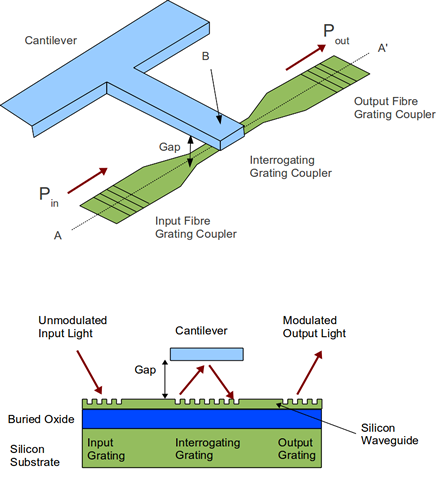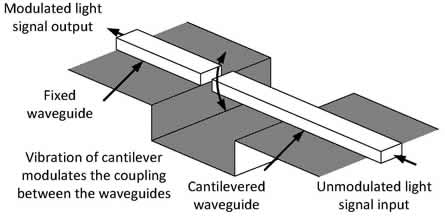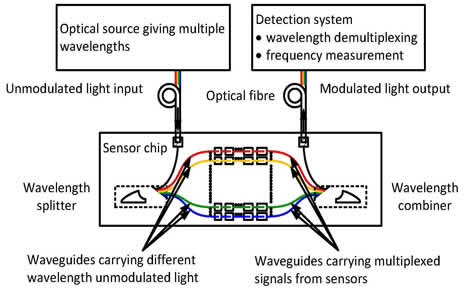 |
Australian National Fabrication Facility |
| Latest News |
December 2010
The Microelectronics Research Group at the WA Node of the ANFF has been working on next-generation optical read-out techniques for micro-electro-mechanical system (MEMS) based biological sensors. Specifically, they are working on various optical techniques which will provide methods for actuating and interrogating incredibly large arrays of micro-cantilever-based MEMS sensors. Using these techniques should provide the ability to build chips containing multi-system, multi-analyte sensors with zepto-gram (10-21g) accuracy.
It is currently possible to build biological sensors using micro-cantilever beams coated with substances specifically designed to bond to whichever chemical substance it is desired to detect. There are two common modes of operation of micro-cantilever sensors. The first is static, where the preferential adsorption of an analyte onto the coated surface causes the cantilever to bend; with the second being dynamic, where the adsorbed analyte changes the mass of the beam and hence its mechanical resonant frequency. The difficulty lies in interrogating the state of these cantilevers in order to determine whether a detection event has occurred. The readout technologies are primarily based on optical techniques developed for atomic force microscopy analysis, in which light is reflected from the cantilever tip to a distant quadrant detector systems and are too large for on-chip integration. The interrogation mechanisms in current commercial systems allow for only 5-10 micro-cantilevers per chip. We wish to increase this by one or two orders of magnitude and improve the statistical detection properties of this class of sensors.
To this end, two separate optical techniques are being tested. In the first technique the sensing cantilever beams are also used as optical waveguides (see Figure 1, below). When the cantilever moves, the coupling of the light through the waveguide is modulated, and the cantilever motion is transferred on to the output optical signal. The second technique uses the cantilever beam as a reflector above a diffraction grating fed by a waveguide – creating an optically resonant cavity. In this case the cantilever motion modulates the optical signal within the waveguide via constructive or destructive interference within the resonant cavity (see Figure 2).
Figure 1 (above): Schematic view of a structure that converts mechanical motion into amplitude modulated optical signal. The conversion is achieved by forming an optical waveguide within the cantilever which is then butt-coupled to another, fixed waveguide, via changes in the coupling efficiency between the two waveguides as the cantilever moves. Figure 2 (right): Isometric and cross-sectional views of the interrogation structure based on diffraction gratings. An optically resonant cavity is formed in the gap between the cantilever and the diffraction grating. The phase relationships at the grating are a function of the separation of the cantilever from the grating, resulting in transmitted light intensity that is quasi-periodic in the separation of the cantilever from the grating |
 |
In the ultimate realisation of the proposed technology, the dynamic mode of operation allows multiplexing of multiple signals onto a single optical carrier, a key attribute needed to address large arrays of sensors. The multiplexing approach will form the basis of a technology for an optical sensor head (incorporating many, potentially thousands) of sensors that is robust, requires no electrical connections, and uses a single optical fibre for addressing and readout (see Figure 3, below). This allows for many diverse applications – ranging from pesticide detection, to wine quality analysis, to non-invasive lung cancer detection. The ability of this biological sensor to sense multiple different chemicals on the same chip will make these technologies an indispensable tool for any type of biological sensing application in the future.
Story by Gino Putrino - Microelectronics Research Group, School of Electrical & Computer Engineering, The University of Western Australia.
|
||
 |
||
Page last updated:
6 November, 2014
|
||




